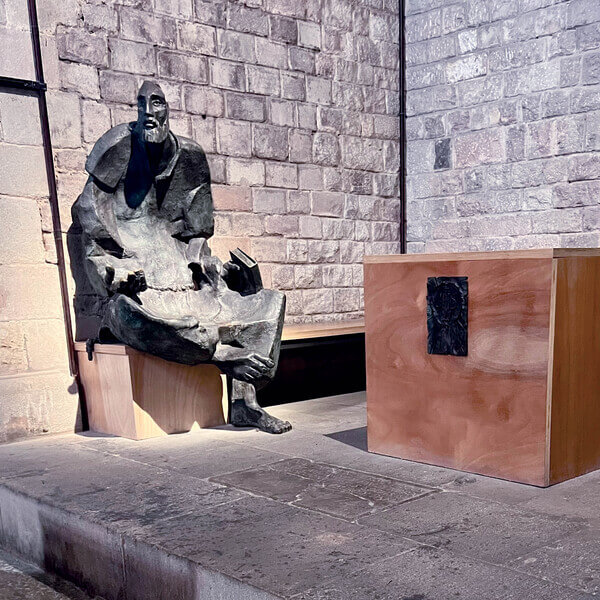The blinding June sun baked everything it touched as I walked up the wide steps of the Church of the Gesu, the Jesuits’ mother church, in Rome.
As my group approached the lone open entrance, a man stood aside the door. What was left of his silver hair was cropped close to his head; his weathered face, featuring a classic Roman nose, bore a wide smile. Clad in grey sweatpants and a red T-shirt, his eyes were bright as he welcomed every person who passed into the church with a quiet but enthusiastic, “Buongiorno.”
His right hand rested straight by his side, palm up. He acted as if he were an attentive maître d’, not a beggar standing on the steps of a church, surrounded by the chaos of Roman traffic jockeying by the piazza as drivers loosely interpreted the country’s traffic laws.
My first thought: How is he wearing long pants in this weather? Second: Do I give him money?
Back home, panhandlers are common, even on my commute to campus. My default approach: Lock your doors, don’t look them in the eye and don’t give them any money, they’ll just spend it on a vice. This, I know, is in direct violation of Jesus’ exhortation in Matthew (a critical one, as he starts with “Truly I tell you …”, his version of: Listen up, this is very important): “Whatever you did for one of the least of these brothers and sisters of mine, you did for me.” I’ve never been able to reconcile this in my everyday life. For me, it’s one of those, “Yes, I know I should, but …” decrees from Jesus.
As my group shuffled to and quickly through the entrance, I debated whether to dig in my bag for money. We’d been approached by beggars in a couple of other parts of the city, but I hadn’t seen anyone in my group drop coin. Don’t be the sucker, I thought as I quickly passed him by. I couldn’t even look the man in the eye. He smiled at me and offered a light “Buongiorno,” anyway.
The minute I walked through the entrance the air cooled, my eyes adjusted to the interior and … I felt terrible. What had I done? Or, more specifically, not done?
With my group, I had spent the past week following the life — and travels — of St. Ignatius, from the quiet green countryside of his family home in northern Spain, to the dry, shadeless pandemonium of Rome. We read and talked about Ignatius extensively in preparation, and one activity was prevalent in his post-conversion life: He was a beggar. Once he set out to give his life to God’s service, Ignatius was determined to live as the poorest of the poor. From Spain, Italy, Paris, and to the Holy Land and back again, for decades he regularly turned down money from those who wanted to directly support him in favor of relying on his trust in God and whatever strangers dropped into his begging bowl.
Realization hit me before I even stepped foot into the nave, the church’s wide central aisle: I had just ghosted a beggar, on the steps of a church dedicated to Ignatius who, incidentally, was interred about 50 yards away to the left of the altar.
Regret trailed me as I followed the group and tried to pay attention to the guide’s description of the 16th-century baroque masterpiece. Had I learned nothing? Or, more accurately, had what I learned not changed my actions? Apparently so. Faith without works, indeed. Then, it hit me: I could catch the man on the way out. In preparation, I dug around my bag and moved coins into my pocket. Perfect.
After the tour and some private prayer time (during which I requested, among other entreaties, forgiveness for this latest transgression), I walked out with the group, excited to right my wrong. But the man was gone; my heart sank. This is going to be one of those random decisions that will stick with me, I immediately thought. It had a definite air of permanent regret, or at least a nagging story that I would forever associate with this trip.
The group broke 90 minutes later for a free afternoon. I headed out solo to do some souvenir shopping and atmosphere soaking. I had no specific destination in mind, simply wandering around the city’s knotted streets, seeing the everyday sights, feeling the weight of unfathomable history seemingly everywhere I looked, like when I turned a corner and, hey, there’s the Pantheon.
Contrition tagged along, too; I couldn’t shake it. The euros in my pocket jangled like the chains of Jacob Marley, every step an aural reminder of my decision. You’re like Peter, I thought. And not the admirable Peter, when Jesus proclaimed him as the cornerstone of the Church, but the failing, human, scared Peter, seated around a fire in the middle of a Jerusalem night. Finally, I moved the coins back into my bag where they wouldn’t make noise. Maybe I’m overreacting, I thought. Stop beating yourself up. You’re probably dehydrated; you need water — and a gelato.



